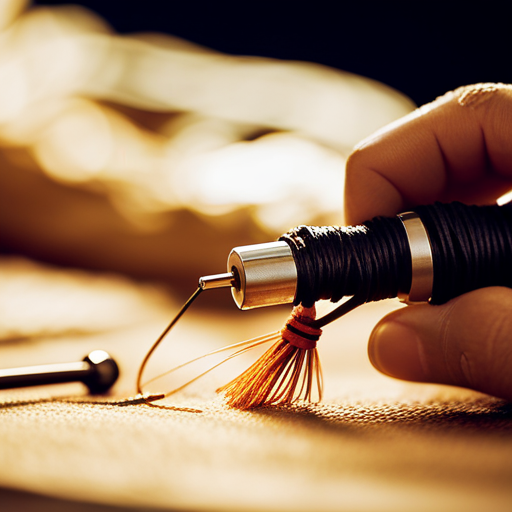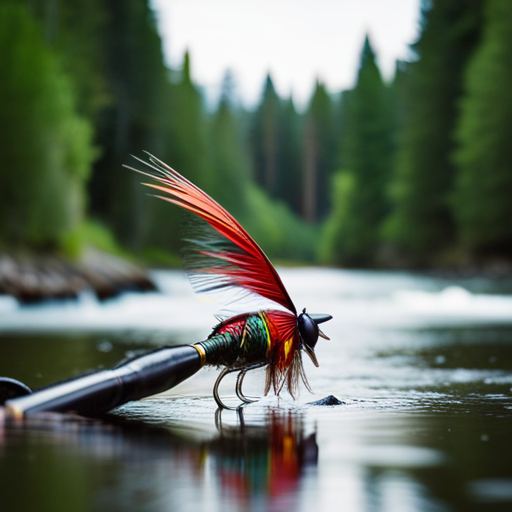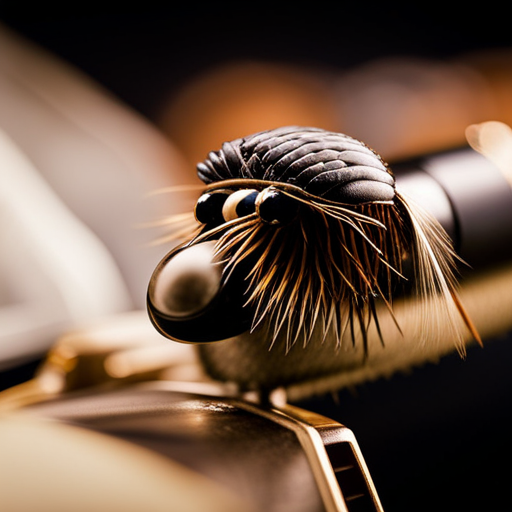Did you know that the right hackle selection can increase the effectiveness of your fly patterns by up to 50%?
In ‘The Art of Hackle Selection and Application in Fly Tying,’ we delve into the intricate world of hackle, exploring types, sizes, colors, and techniques for optimal application.
Whether you’re a beginner or seasoned fly tier, this comprehensive guide will enhance your understanding and mastery of this essential element in fly tying.
Understanding Hackle Types
Understanding the various types of hackle and their specific applications is essential for achieving optimal results in fly tying. Hackle texture and durability are crucial factors to consider when selecting the right feathers for a fly pattern. The anatomy and structure of hackle feathers play a significant role in determining their suitability for different fly tying techniques.
Hackle feathers come in various textures, ranging from stiff and webby to soft and flexible. Stiffer hackle feathers are ideal for creating dry flies, providing buoyancy and stability on the water’s surface. On the other hand, softer feathers are well-suited for wet flies and nymphs, imparting lifelike movement to the fly underwater. Understanding the texture of hackle feathers enables fly tyers to choose the right material for achieving the desired presentation of their flies.
Durability is another critical aspect of hackle selection. Strong, durable feathers are essential for flies that will withstand multiple strikes from fish or turbulent water conditions. By understanding the anatomy and structure of hackle feathers, fly tyers can discern which feathers will endure the rigors of fishing and provide long-lasting performance in their fly patterns.
Selecting the Right Hackle Size
Continuing from our exploration of hackle types, the selection of the right hackle size is essential for achieving the desired performance and appearance in fly tying. When selecting hackle feathers, it’s crucial to consider both the texture and length of the feathers.
The texture of the hackle feathers determines how they will interact with the water. Soft feathers offer more natural movement in the water, while stiffer feathers provide greater buoyancy.
Additionally, the length of the hackle feathers is important in determining the silhouette and profile of the fly. Longer feathers are typically used for larger flies, whereas shorter feathers are suitable for smaller patterns.
Understanding the characteristics of hackle feather texture and length allows fly tyers to match the right size of hackle to the intended fly pattern, ensuring that the finished fly performs as intended.
Once the appropriate hackle size is selected, the next crucial step is to explore the range of hackle colors available, which will be discussed in the following section.
Exploring Hackle Colors
When considering hackle colors in fly tying, it is essential to focus on matching the natural tones of the insects being imitated. This attention to detail ensures that the fly appears as realistic as possible to the fish.
Additionally, experimenting with different color combinations can create visually appealing flies that entice fish to strike.
Matching Natural Insect Tones
To achieve an authentic imitation of natural insect tones, fly tyers must carefully select hackle colors that closely resemble those found in the targeted insect species. When matching natural insect tones with hackle colors, fly tyers should consider the following:
-
Research the Insect Species: Study the natural tones of the insect species being imitated to understand the specific color variations.
-
Blending Hackle: Utilize a combination of two or more hackle colors to create a more accurate representation of the natural insect tones. Experiment with different combinations to achieve the desired color blend.
-
Insect Imitation: Pay attention to the nuances in color and texture of the insect species’ body and wings, and select hackle colors that mimic these characteristics.
Creating Attractive Color Combinations
In exploring hackle colors for creating attractive color combinations, fly tyers should carefully consider the specific color variations of the targeted insect species and blend two or more hackle colors to achieve an accurate representation of natural tones. Understanding color theory is crucial in this process, as it allows for the selection of complementary or analogous colors to enhance the fly’s visual appeal. Fly tying aesthetics play a significant role in determining the overall attractiveness of the finished fly. By harmonizing hackle colors based on the principles of color theory, tyers can create visually appealing and effective flies that mimic the natural insect tones. The table below provides some examples of effective hackle color combinations based on common insect species.
| Insect Species | Hackle Color 1 | Hackle Color 2 |
|---|---|---|
| Mayfly | Olive | Light Cahill |
| Caddisfly | Tan | Ginger |
| Stonefly | Black | Brown |
Techniques for Wrapping Hackle
Now that we’ve explored the different colors of hackle, it’s essential to understand the techniques for wrapping hackle effectively. Proper hackle wrapping is crucial for achieving a well-proportioned and balanced fly.
Additionally, choosing the right hackle size is a key factor in creating a fly that behaves as intended.
Proper Hackle Wrapping
The proper wrapping of hackle is a critical technique in fly tying, requiring precision and skill to achieve the desired results. To master this technique, fly tyers can utilize advanced hackle techniques, such as the following:
-
Palmering: This method involves evenly wrapping the hackle around the hook shank to create a uniform and full-bodied appearance.
-
Tip: Start at the hook eye and work towards the bend for optimal coverage.
-
Counter-wrapping: By wrapping the hackle in the opposite direction of the ribbing, fly tyers can achieve increased durability and a distinct visual effect.
-
Tip: Use this method when aiming for a more robust fly pattern.
-
Stacking hackle: This advanced method involves carefully aligning and securing multiple hackle feathers to create a layered and textured look.
-
Tip: Experiment with different feather lengths for a unique aesthetic.
Choosing Hackle Size
Proper selection of hackle size is essential for achieving precise and effective wrapping techniques in fly tying, ensuring the creation of well-balanced and visually appealing fly patterns. When choosing hackle feathers, it’s crucial to consider their sizing and qualities. The table below illustrates the correlation between hook sizes and recommended hackle sizes, aiding in the selection process.
| Hook Size (US) | Recommended Hackle Size |
|---|---|
| 4-8 | Large |
| 10-14 | Medium |
| 16-20 | Small |
Once the appropriate hackle size is determined, the manipulation and shaping of the feathers play a significant role in achieving the desired aesthetic and functional characteristics of the fly. Effective manipulation techniques ensure the proper alignment and distribution of the fibers, resulting in a well-proportioned and buoyant fly pattern.
Adjusting Hackle Density
To achieve the desired hackle density in fly tying, it is essential to carefully select and prepare the appropriate number of feathers for each pattern. Once the feathers are chosen, adjusting the hackle density can be achieved through the following methods:
-
Hackle trimming, adjusting
-
Trim the excess fibers from the base of the hackle plume to reduce density.
-
Adjust the density by selectively removing fibers from the feather’s stem.
-
Hackle plume, shaping
-
Shape the hackle plume by stroking the fibers in the desired direction to increase or decrease density.
-
Use techniques such as folding or wrapping the hackle to control density and achieve the desired effect.
By employing these methods, fly tyers can easily modify the hackle density to suit specific patterns and fishing conditions. This level of control allows for precise adjustments, ensuring that the resulting fly meets the desired characteristics and performance criteria.
Now, let’s delve into the next section and explore how hackle can enhance various fly patterns.
Enhancing Fly Patterns With Hackle
Enhancing fly patterns with hackle involves refining the application of abstract principles discussed in the previous section, allowing for meticulous manipulation of the feathers to achieve specific aesthetic and functional objectives. Hackle application plays a crucial role in enhancing the overall appearance and performance of a fly pattern. When strategically applied, hackle can impart lifelike movement, improve buoyancy, and create a more appealing silhouette.
One aspect of fly pattern enhancement through hackle application is the incorporation of different types of hackle feathers. By blending different feather types such as dry fly hackle, saddle hackle, or soft hackle, tiers can create unique textures and profiles that enhance the fly’s effectiveness. Additionally, varying the density and length of the hackle fibers can further customize the fly’s appearance and behavior in the water, making it more enticing to fish.
Furthermore, the coloration of hackle feathers can be utilized to enhance fly patterns. Incorporating contrasting or complementary colors through hackle application can mimic natural prey more effectively, potentially increasing the fly’s attractiveness to fish.
Tips for Troubleshooting Hackle Issues
When encountering difficulties with hackle in fly tying, meticulous attention to detail and a thorough understanding of the feathers’ properties are essential for resolving any issues effectively. Troubleshooting hackle issues requires a systematic approach and advanced hackle techniques to achieve desirable results. Here are some tips for troubleshooting hackle issues:
-
Feather Selection: Ensure that you are using the appropriate type and size of feathers for the specific fly pattern. Different feathers have varying stiffness and barb length, so selecting the right feathers is crucial for achieving the desired look and movement in the water. Pay attention to the curvature and web of the feathers to gauge their suitability for the intended pattern. Experiment with different feather types to understand their unique characteristics and how they affect the overall appearance and performance of the fly.
-
Proper Preparation: Preparing the feathers adequately before application is vital. Improper preparation can lead to difficulties in wrapping the hackle around the fly’s body, resulting in a messy appearance and compromised durability. Use techniques such as preening, steaming, or trimming to optimize the feathers for tying.
-
Application Techniques: Mastering advanced hackle application techniques, such as palmering and stacking, can help troubleshoot issues related to uneven distribution, slippage, or bulkiness in the finished fly.
Frequently Asked Questions
Can Hackle Be Reused for Multiple Fly Tying Projects, or Is It a One-Time Use Material?
Hackle reusability depends on quality and care. While some can withstand multiple uses, others degrade quickly. Considering sustainability, reusing hackle reduces environmental impact. Proper storage and handling can extend hackle lifespan and support sustainable fly tying practices.
Are There Any Environmental or Ethical Considerations to Keep in Mind When Using Hackle in Fly Tying?
When using hackle in fly tying, it’s crucial to consider the environmental impact and ethical sourcing. For instance, sourcing feathers from sustainable and ethical suppliers ensures minimal environmental impact and supports responsible animal welfare practices.
How Does the Quality of Hackle Feathers Affect the Overall Durability and Lifespan of a Fly?
The quality of hackle feathers significantly impacts the overall durability and lifespan of a fly. High-quality feathers with strong barbs and flexible stems enhance the fly’s longevity, ensuring it withstands the rigors of fishing.
Can Hackle Be Dyed or Customized to Achieve Specific Color Variations Not Readily Available in Stores?
Creating customized color variations in hackle feathers involves a meticulous dyeing process. Natural dyes yield rich, authentic hues, while synthetic dyes offer versatility. Color matching techniques ensure precise results, enabling fly tyers to achieve unique and vibrant palettes.
Are There Any Alternative Materials or Techniques That Can Be Used to Achieve Similar Effects to Hackle in Fly Tying?
When exploring alternatives in fly tying, considerations for achieving similar effects to hackle can involve utilizing synthetic fibers, natural alternatives, and innovative materials. Different techniques can be employed to achieve desired results.
Conclusion
In conclusion, hackle selection and application may seem like a simple task, but there are many nuances to consider in order to achieve the perfect fly pattern.
From understanding different hackle types to mastering techniques for wrapping and adjusting density, the art of hackle selection is truly an intricate and important aspect of fly tying.
So next time you sit down to tie a fly, remember that the smallest details can make the biggest difference.




